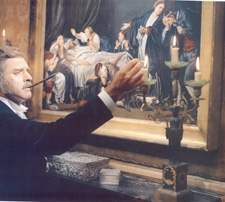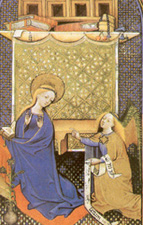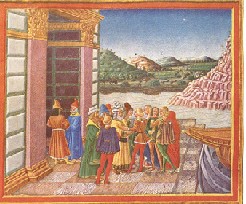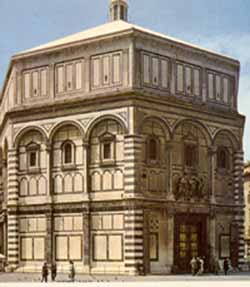Undergraduate:
Italian 80. Introduction to Italian Cinema. From Silents to the New Anti-Mafia Films.
This course introduces cinema as a medium, teaching vocabulary of film analysis, criticism, and theory; introduces Italian cinema through the work of twelve major directors from 1912 to the present, focussing on major movements and genres, while exploring the close connections between film and national culture in Italy; provides a cultural background on Italian history and society since the Risorgimento (unification movement) in the nineteenth century, considering such issues as the struggle for independence, Fascism and the Holocaust, nationalism vs. regionalism, gender roles, and contemporary problems of government corruption and the Mafia. Cross-listed with Comparative Literature and Film Studies.
Italian 260. Worldviews in Collision. The Counter Reformation and Scientific Revolution
An exploration of the radical conflicts that developed in Europe when the authority of the Roman Catholic church was challenged by the Protestant reformers and new scientific discoveries in the sixteenth and seventeenth centuries. Machiavelli, Luther, Copernicus, and Galileo, seen through their own writings, those of their contemporaries, and as they have been recreated by two twentieth-century playwrights (Osborn, Brecht): Counter Reformation Art (the “Mannerist” Style, the Baroque, Marino, the Marinisti), and an Italian Utopia (Campanella).
Through a range of authors including Augustine, Dante, Petrarch, Galileo, and Umberto Eco, this course will explore the world of the book in the manuscript era. We shall consider 1) readers in fiction-male and female, good and bad; 2) books as material objects produced in monasteries and their subsequent role in the rise of the universities; 3) medieval women readers and writers; 4) medieval ideas of the book as a symbol (e.g., the notion of the world as God’s book; 5) changes in book culture brought about by printing and electronic media. Lectures with discussion in English, to be supplemented by slide presentations and a field trip to the Rare Book Room in Van Pelt Library. No prerequisites. Satisfies General Requirement in Arts and Letters.
Graduate:
Italian 531-532. The Divine Comedy.
A close reading of the Commedia in its medieval cultural contexts. Among topics to be explored are literary antecedents from antiquity (especially Virgil’s Aeneid, the vernacular heritage, including the Provencal, Sicilian, and stilnovistic writers and earlier works by Dante himself; the commentary tradition (e.g., Benvenuto da Imola, Boccaccio), medieval esthetic theory and Dante’s poetics, numerology, and the Commedia in the visual tradition (portraits of Dante, charts and maps of Dante’s Otherworld, illuminated manuscripts and paintings inspired by the poem. Cross-listed with Comparative Literature. Taught in alternating years on a rotating basis with K. Brownlee.
This course presents both poetry by women and about women, following in its first half the Romance lyric tradition from the 12th-c. Provencal Troubadours and their female counterparts, the Trobairitz, into the Sicilian School of the Duecento, the Tuscan Dolce Stil Novo, Dante’s early “Stony Rhymes,” and Petrarch’s 14th-c. love poetry. The second half of the course will be devoted to Renaissance lyric, when Petrarchism becomes a European fashion, producing numerous polyvocal anthologies. We shall consider how Petrarch’s “Scattered Rhymes” undergo a transformation into Petrarchismo, why this literary mode makes possible a flowering of poetry by women, how the women adapt a first-person male lyric voice to their own purposes (as maiden, wife, widow, courtisane), and how they gain acceptance by the male establishment (e.g., Bembo, della Casa, Michelangelo, Varchi, Bronzino, Cellini) in the art of poetry as “epistolary” exchange, or dialogue, linking members of a cultural community. Our female authors will include Vittoria Colonna, Chiara Matraini, Tullia d’Aragona, Isabella di Morra, Gaspara Stampa, Veronica Franco, and Laura Battiferra degli Ammannati Their varying critical reception will raise larger questions: how do women enter a national literary history? Is their presence less stable than that of male authors? Do all-female canons reflect lines of literary influence or are they a kind of virtual matroneum that segregates and diminishes the female voice? Cross-listed with Comparative Literature and Women’s Studies.
Italian 537. Boccaccio’s Women. Female Identities in the Middle Ages.
This course will focus on the writings of Giovanni Boccaccio, the “father” of Italian fiction, in order to explore issues of female identities in the Middle Ages. Texts will represent the range of Boccaccio’s corpus, from vernacular fiction to Latin history, including the first female biographies of Western Europe. His versatile literary imagination, which created both works in praise of women and savage misogyny, reflects a rich cultural heritage descended from classical and Christian traditions-the Bible and its patristic commentators, Aristotle and the Scholastic philosophers, Latin literature, medieval romance, and the poetry of courtly love. Selections from these philosophical, theological, scientific, and literary sources will supplement our primary readings as we recreate a panoply of medieval women and images of the female, from perfecting agent to an error of nature, from allegorical personification to aristocratic patron. Cross-listed with Comparative Literature and Women’s Studies.
Italian 537. Boccaccio Visualized. (Taught every three years)
This course presents Giovanni Boccaccio and his literary corpus from three visual perspectives that capitalize on the 8,000 medieval and Renaissance images inspired by Boccaccio’s writing. Focus will be on the Decameron, with selections from his literary criticism, biographies, and mythography (Defense of Poetry, Life of Dante, Life of Petrarch, Famous Women, Teseida). As we read, we shall 1) look at portraits of Boccaccio, 2) look at Renaissance illustrations of his writings, 3) search for visual intertexts-i.e., explore how images and material artifacts in Boccaccio’s culture could have influenced his writing, and how our recovery of those icons serves us as literary interpreters. Cross-listed with Comparative Literature.
This course reconstructs traditions of Western number symbolism from antiquity (Plato, the Pythagoreans) and the Bible to the early modern period with readings both in encyclopedic treatises on Arithmetic (Macrobius, Martianus Capella, Rabanus Maurus) and in literary texts that are numerical compositions (Augustine’s Confessions, Petrarch’s epistle on the ascent of Mt. Ventoux, Dante’s Vita nuova and Commedia, Boccaccio’s Diana’s Hunt, the Old French Vie de St. Alexis, and Umberto Eco’s The Name of the Rose). Discussion will focus on numerology as it relates to the medieval esthetic of order, the literary text as microcosmic counterpart to God’s macrocosm, veiled meaning, and “difficult” poetics. We shall also consider the end of the tradition and what changes in science and culture brought about the disappearance of number symbolism in literature, except for a few moderns (e.g., Thomas Mann, Samuel Beckett). Students will do a final project (oral presentation and paper) on a text of their choosing from any period, national literature, or another medium–e.g., architecture, music. Cross-listed with Comparative Literature.







